
views
Providing First Aid for the Kitten

Recognize the signs of a broken leg. You should check for the signs of a broken leg before administering any first aid. This can help you figure if your cat needs to see your vet or if there may be another issue. Signs your kitten may have a broken leg include: Reluctance to put weight on the leg Limping Swelling Pain or tenderness Limb deformity or unusual bends in the leg Rapid breathing Broken skin and/ or a visible bone Not eating or grooming Crying, howling, moaning, or growling
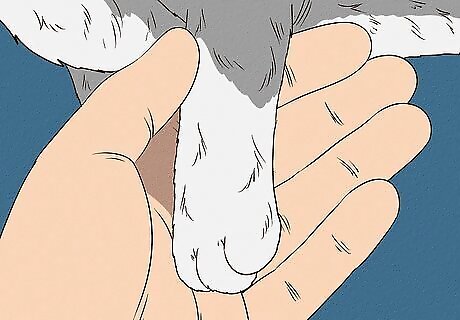
Check your kitten gently. No matter how sweet your kitten is, it may bite or scratch you because of the injury. Take great care when examining your kitten’s leg to minimize the risk of biting or scratching. Maintain a safe distance between the kitten’s mouth and your face. Avoid attempting to hug it. Examine the leg slowly, carefully, and as gently as possible. Reassure your kitten in a soft voice. Stop looking for signs if your kitten becomes agitated.

Contact your vet or an emergency animal clinic. Once you’ve checked your kitten’s leg, call your vet’s office. Explain to the office staff that your kitten may have a broken leg to get an appointment as soon as possible. If your vet isn’t available, take your kitten to an emergency clinic to ensure it gets prompt care. Calling ahead can also alert the vet that you are coming so they can prepare to treat your kitten as quickly as possible. Give as much information as possible about your kitten’s symptoms. Ask any questions you have, such as what type of first aid to provide and the best way to transport kitten to the office.
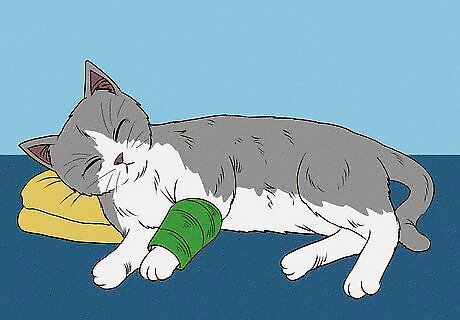
Stabilize the kitten’s leg. Before you take your kitten to the vet, stabilize its leg with a splint or bandage. This can reduce the risk of further injury or pain. Only stabilize the leg if your kitten allows it. Place a towel or blanket gently over your kitten’s head to prevent it from biting. Make a splint with items such as the cardboard center of paper towel or toilet rolls, rolled up newspaper, or towels. Put the splint next to the broken area. Use a bandage, pantyhose, or surgical tape to keep the splint in place. Add padding around the splint to reduce your kitten’s discomfort. Avoid pushing any exposed bone back through the broken skin. In this case, place some sterile gauze or a period pad over the area and then splint it.

Transport your kitten to the vet. The only way to safely treat a kitten’s broken leg is with veterinary care. After you’ve stabilized the leg and informed the vet that you are coming, take your kitten to the office for treatment. Wrap your kitten in a thick towel or place it on a rigid surface for the car ride. This can minimize your kitten’s discomfort the risk of further injury. Place your kitten in a crate, carrier, or open box to keep it from moving around the car. Put it in the back passenger side seat so that you can watch your kitten through your rearview mirror. Use a seat belt around the front of the crate or carrier to secure it.
Getting Veterinary Treatment
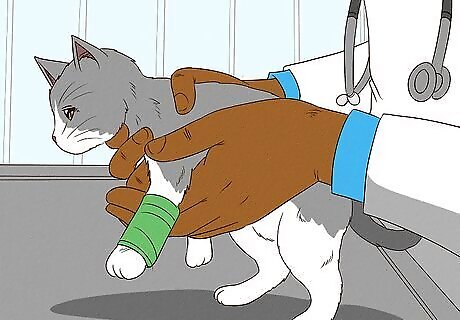
Visit the vet. You’ll need to seek prompt veterinary care if your kitten’s leg is broken. Veterinary care is the only way to confirm a broken leg. It also ensures that your kitten gets proper treatment to heal the leg. Let the vet know any symptoms your kitten has and how the injury occurred. For example, say, “Snowball has been limping for a couple of days. I’m not sure how she got hurt. She limps and holds her right leg up when she walks.” Answer any questions your vet may have about the injury or your kitten.

Undergo an examination. Your vet will perform an examination of your kitten. This may include further testing such as X-rays. The exam and tests help the vet figure out exactly where the break is and develop the best treatment plan. Recognize that the vet may touch or press certain points of your kitten’s leg to feel if they’re swollen, sore, warm, or out of place. The vet may also place your kitten on the ground to see it walk. Your kitten may also undergo an X-ray or have an ultrasound or MRI to detect internal damage.
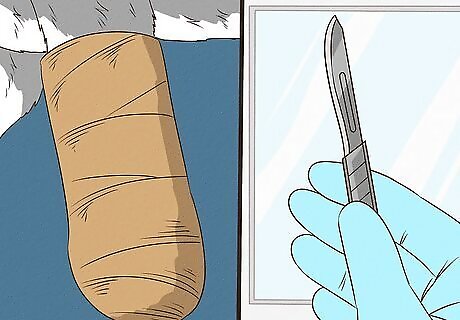
Follow your vet’s treatment plan. Your vet will suggest a course of treatment for your kitten’s broken leg. The type of treatment will depend on the break’s severity and your kitten’s overall health. Follow any instructions your vet provides for the kitten’s treatment, including giving your kitten antibiotics. Your vet may consider treating your kitten with: A cast or splint Surgery, especially if the surrounding tissue is damaged Amputation for very severe breaks
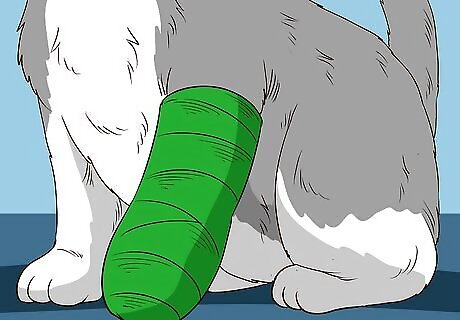
Immobilize your kitten’s leg. Simple breaks in one spot on your kitten’s leg or breaks that haven’t torn tissue often require immobilization with a cast or splint. Most immobilization treatments take 4-6 weeks to heal. Observe if the vet uses a rigid cast or more secure splint on your kitten’s leg. Casts are constructed with plaster and splints may be plastic, plaster or aluminum. Ask your vet if extra padding can make your kitten more comfortable. Put a sling around the leg for up to 10 days if your kitten’s vet prescribes it. This can keep your kitten from moving and walking. Avoid getting the cast or splint wet to allow the break to heal. Leave any casts or splints in place until the vet removes them.
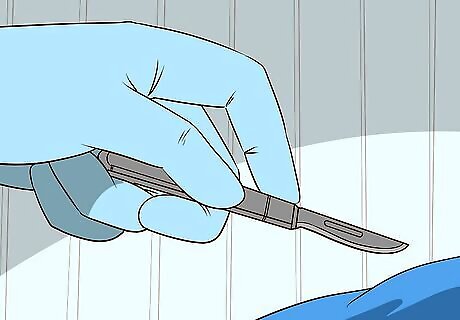
Consider surgery. If your kitten has a very severe break, your vet may suggest surgery. This can stabilize the bone, joints, and surrounding tissues, which will help your kitten heal properly. In especially severe breaks, amputation may be necessary. Authorize any recommended pre-surgical tests to make sure your kitten is healthy enough for surgery. Ask the vet what type of surgery is best for your kitten. It may be using pins, wires, or screws to stabilize the leg. It may also be amputation. Follow any post-operative instructions from the vet. This includes restricting activity for 2-4 weeks, a course of antibiotics or pain medication, and having pins and screws removed.
Comforting Your Kitten
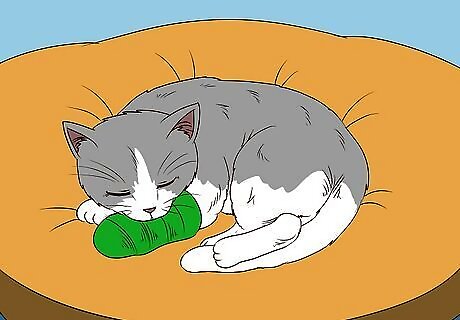
Let your kitten rest. A broken leg can be very traumatic for your kitten. Give your kitten as much rest as possible while it is injured. Rest aids healing and minimizes pain or discomfort. Restrict your kitten’s movement, especially jumping, as much as possible.
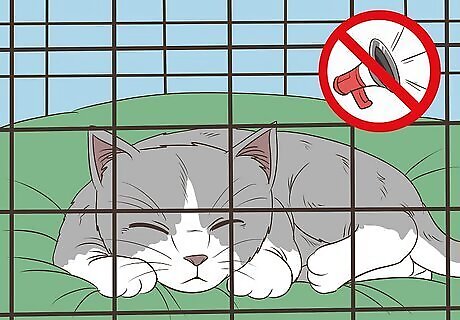
Create a cozy and quiet spot. One way to help restrict movement and comfort your kitten is creating one area in which to sleep, eat, and use the litter box. It can be an entire room or in a crate. This can ensure your kitten doesn’t need to move often and doesn’t waste energy that is better spent on healing. Place a warm blanket in the area, which can provide warmth and comfort to your kitten. Consider putting it in a space that allows you to lay down with your kitten. This can give your kitten extra comfort. Make sure your kitten has clean food and water in the area. Your kitten may not want to eat or drink much until it starts feeling better. Put a small litter box or bathroom pad in the area. Take your kitten to it every hour so that it doesn’t have to put any weight on the leg.
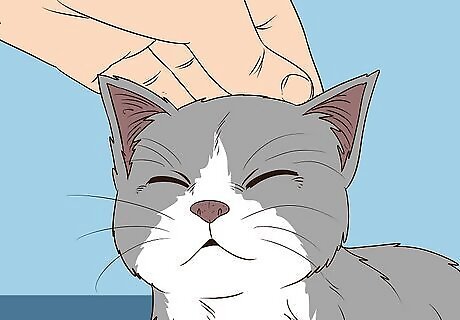
Pet your kitten gently. Your kitten may be scared or cry because of the break or treatment. Pick up your kitten or sit by the blanket and gently pet it. This can calm your kitten and provide reassurance. Stroke your kitten’s head, neck, and under the chin. Avoid the broken leg and any spots that are sensitive. Your kitten may also not want to be pet. If this is the case, give it some space until it is ready for contact again.

Talk to your kitten. In addition to touch, talking can also provide your kitten comfort and reassurance. Any you’re your are with your kitten or checking in on it, give a few comforting words. Maintain a soft voice so you don’t scare your kitten. Include your kitten’s name and offer praise while you talk. For example, “I know you’re hurting and scared, Sam? You’re being such a good kitten.” Consider gently stroking your kitten when you talk to it.



















Comments
0 comment